Nowadays, we see marketing flywheel dominate the internet. From Amazon to Hubspot, the flywheel has proven a successful marketing approach. Many popular and experienced marketers suggest it as a great strategy to increase customers. But what is a flywheel? Is it better than a funnel? How to build it?
Here’s everything that you are looking for.
What Is A Marketing Flywheel?
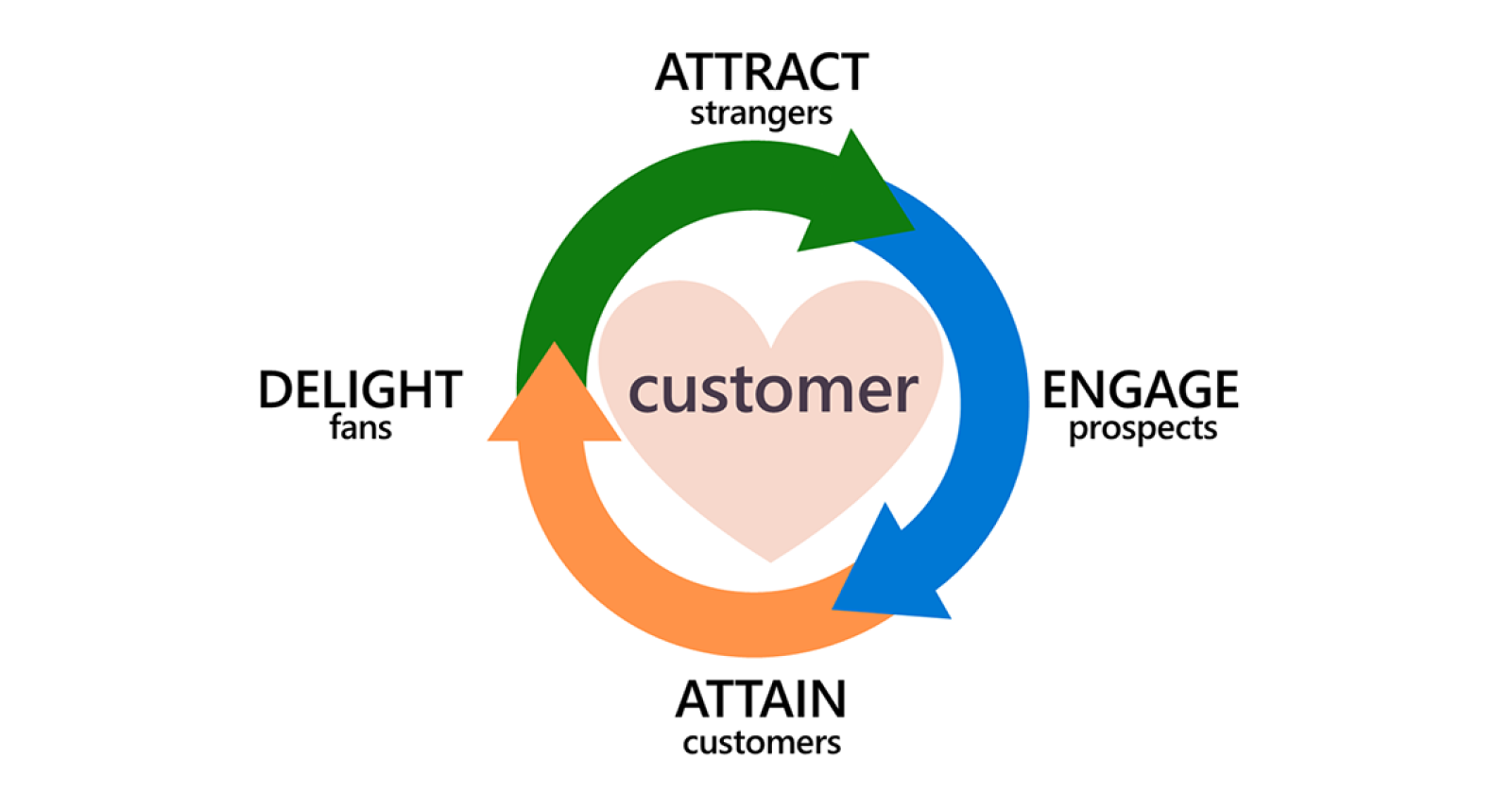
Image Credit: brandpoint
According to Jon Dick of HubSpot, a Marketing Flywheel is a “circular process where clients feed growth.” It is the upgraded version of the traditional marketing funnel.
CHECK OUT OUR DETAILED GUIDE ON MARKETING FUNNEL IF THIS TERM SOUNDS NEW TO YOU!
Practical Example: There’s this guy named Sam, looking to purchase a new pair of shoes online. He searched for “Nike Air shopping” on Google and clicked on the first website on his search results. Sam scrolled through the collection, added his favorite pair of shoes in the cart, entered the payment information, and placed the order. Now that’s not the end of the story.
He became a loyal brand customer and started promoting it to others. But why did he do that? Because he entered the marketing flywheel of that business which encouraged him to stick with them for a long time. That’s how a marketing flywheel uses existing customers to attract new leads.
Things To Focus – How did Sam get attracted to that brand’s website in the first place? Because he saw it on the top of his search results. “Do you know that 56.36% of all clicks go to the top-ranked website”? Either that brand might have used PPC or SEO to achieve that rank. You can do the same.
LEARN TO RANK HIGH USING SEO
AND CLICK HERE FOR AN IN-DEPTH PPC GUIDE!
Now when you know what a marketing flywheel is and how it brings more sales and leads, it’s time to dig a little deeper. First, let’s discover the components of a marketing funnel:
Components Of Marketing Flywheel

A customer’s journey is described in numerous stages in a traditional marketing funnel, starting from awareness and ending at conversion or purchase. The structure of the flywheel is quite similar. But it consists of only 3 phases:
Attract- In this stage, potential customers get aware of your business. They develop an interest in your brand, assuming you provide a solution to their problems.
Engage- This phase includes providing education, solutions, and personalized customer services to the visitors.
Delight- In this step, businesses focus on creating a positive shopping experience and strong relationship with the customers to become your promoters, helping the flywheel spin back to the first stage.
Let’s unfold these phases from deep and understand the marketing strategies in each:
First Phase- Attract
The first step of an inbound marketing flywheel is attracting people to enter the wheel. This step is similar to the first step of the marketing funnel. Attracting potential customers isn’t hard if you give them hope to solve their issues. Therefore, this phase encourages the customers to start their buyer’s journey.
Example- Sam was scrolling through his Facebook account when he came across an advertisement for an organic hair shampoo that “controls hair fall within one week.” Sam got curious to know more about that product. So he clicks on it, visits the website, and enters the marketing flywheel of that brand.
Real-Time Example: Inshorts

This image is an Instagram ad for Inshorts. By asking questions like- “don’t have time to read the newspaper?” it grabs the user’s attention. And the caption below creates interest, encouraging the visitor to click on “Install Now” and discover if it’s possible to read a newspaper in 2 minutes. And that’s when this brand succeeded in making a visitor enter its flywheel.
Following are the tactics you can use to gain your target lead’s attention and bring them to your website:
- Content marketing and blog posts
- Social media presence- both paid and organic
- On-page SEO, off-page SEO, and keyword strategy
- PPC and video campaigns
Second Phase – Engage
After the customer reaches your website or enters the first stage of your flywheel, the next step is to offer them more quality content or information. Your focus should be on convincing them to purchase your product or services. And the only way to convince them is to resolve some of their issues through your content.
Example: Sam is now reading the product description of that organic shampoo. The brand has provided useful content about the product, like how it controls hair fall, the benefits of ingredients present in it, and much more. But it isn’t enough to convince him about purchasing it. So, he watches a few videos of the product, reads reviews and testimonials of previous customers, all provided by the seller. Now he has everything needed to make his decision. Finally, Sam is convinced to purchase this product because he is suffering from hair fall issues, and he is completely sure that this shampoo is the right cure.
Practical Example: Amazon
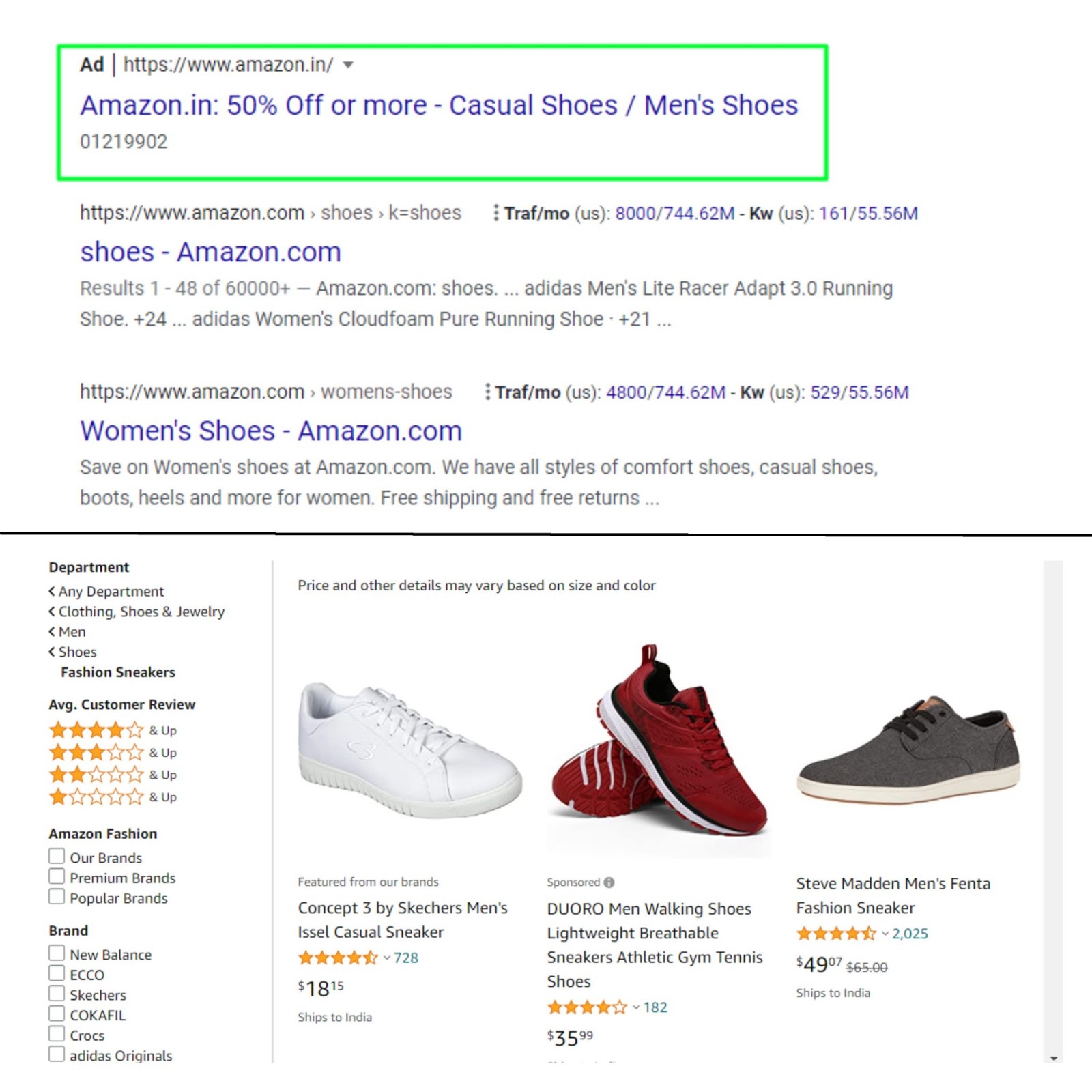
- The brand grabs visitors’ attention by offering them a great deal.
- Leads get interested to know more about it, so they click on the ad.
- The ad directs them to the landing page, where they find various products. In our case, they are shoes.
- The prices are affordable, so users scroll down the collection.
- They pick a product to learn more about it in detail through the description.
- The product fulfilled their needs, so they decided to finalize their choice.
And that’s how Amazon brings their visitor to its flywheel sales model and successfully moves them on to the second phase.
Fill your website with as much useful and quality information as you can. It will help you build a stronger and long-lasting relationship with your customers. The tactics you can use in the engage phase are:
- Segmented email campaigns
- Free demos and gated content like downloadable templates, eBooks, and whitepapers.
- Visual content like detailed explainer videos and webinars.
- Offering a free trial of your services or products.
Example: Amazon

It is one of those brands using the above tactics. In addition, most of their product pages include detailed explainer videos to help the user better understand the product. This way, they increase their user engagement rate, strengthening their customer-business relationship.
Third Phase- Delight
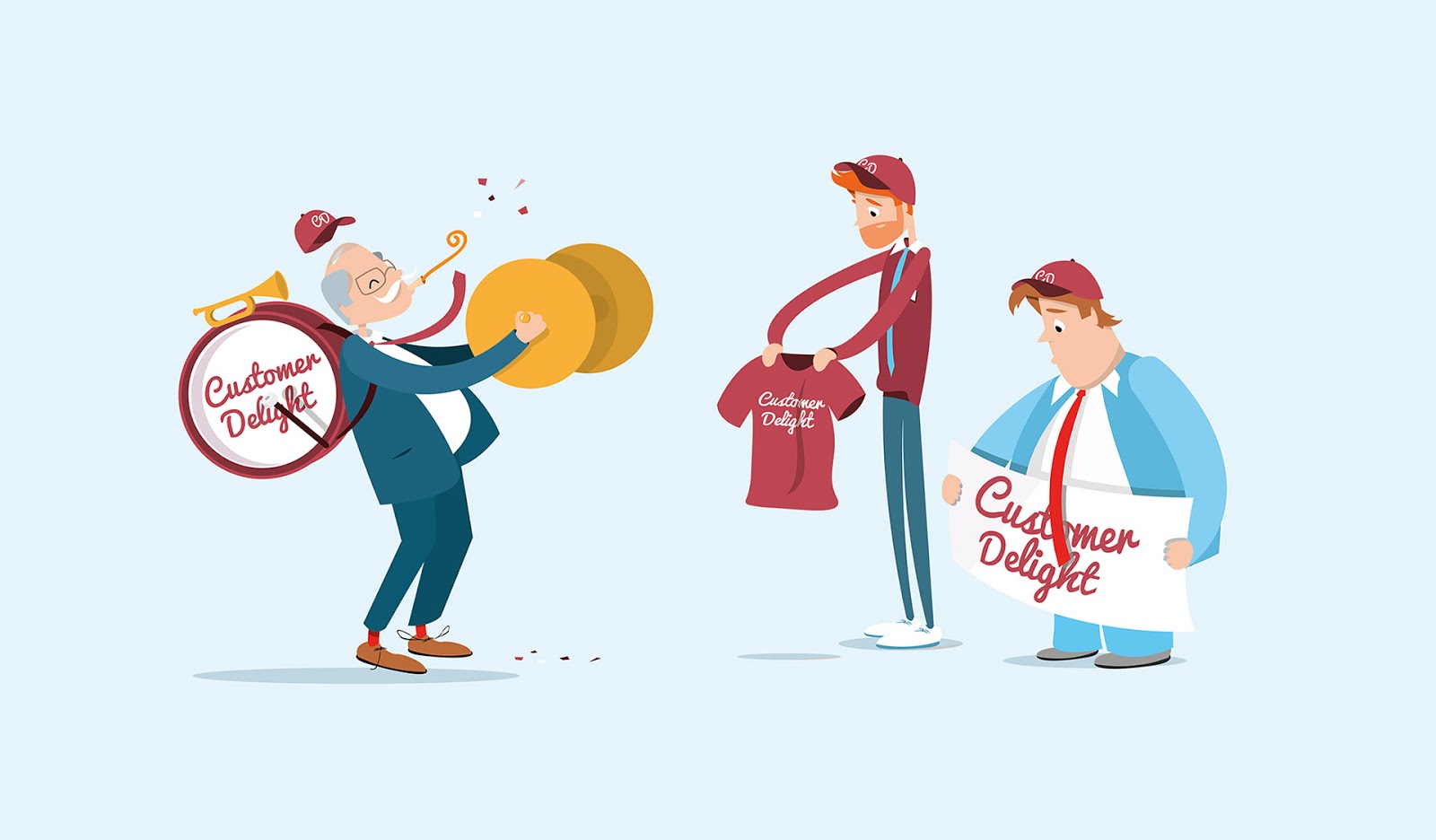 This phase separates the marketing flywheel from the marketing funnel. What happens in a funnel is-
This phase separates the marketing flywheel from the marketing funnel. What happens in a funnel is-
- Visitors get attracted to your brand.
- They engage with your content.
- They decide to convert into customers.
- Finally, they purchase your product or services and get converted into clients.
- They exit the funnel, and the process starts from the top again.
Do you notice something? The marketing funnel does not give any reason to your clients to come back again. But the flywheel does. If you have reached this phase and helped your visitors gain solutions for their specific issues, all while providing them extraordinary customer services along the way, then you have gold in your hands.
You have successfully created a happy customer that values more than gold. In this phase, your job is to nurture the relationship you have created.
“In The Third Phase, Your Goal Is To Create Promoters For Your Brand.”
This end-to-end circle is how you can complete the cycle of the flywheel. By creating the promoters, you can ensure that the wheel keeps on moving, thus ensuring the constant growth of your business.
Example: It has been weeks since Sam ordered that shampoo. He had issues with the delivery, but they all got resolved because of the premium customer support of the brand. Sam is now recommending all his friends and acquaintances to try products from that company. He has become a loyal customer because that brand offered him superior quality services from the starting itself.
Harriet, the co-founder of CocoFinder, says- “one of the biggest and notably the most important advantages of using the Flywheel Model is that it helps focus on enhancing a customer’s journey even after they’ve matured into a customer. Nurture them from the very first moment they become a customer up until the stage when they turn into subject matter experts (gain expertise in our product or service) and brand advocates.”
Following are the list of tacts that you can use in this phase to make your customers loyal to your business:
- Hosting networking events.
- Offering exclusive “premium membership only” content in the form of webinars or eBooks.
- Personalized email campaigns
- Creating referral programs
- Inviting the clients to try new products, services, and features.
Just like the marketing funnel, there are various types of marketing flywheels. Let’s give you a few examples:
Popular Types Of Flywheel
Organic Flywheel

In an organic marketing flywheel, you have to publish the highest quality SEO-friendly content on your website and then promote it across online channels like- email, social media, etc. Doing this attracts target visitors who will engage, share and visit your content multiple times, boosting your website’s authority, helping you rank better on search engines.
Why Named Organic?
This flywheel is named organic because it uses organic tactics like SEO to attract organic attention. To keep your organic leads engaged with your website for a long time, you can take the help of a chatbox.
This facility makes it easy to start a conversation with the visitor. So many companies have benefited from the organic flywheel, including Bugger, HubSpot, Moz, Drift, and many more. If they are getting results from it, why can’t you?
PR Flywheel
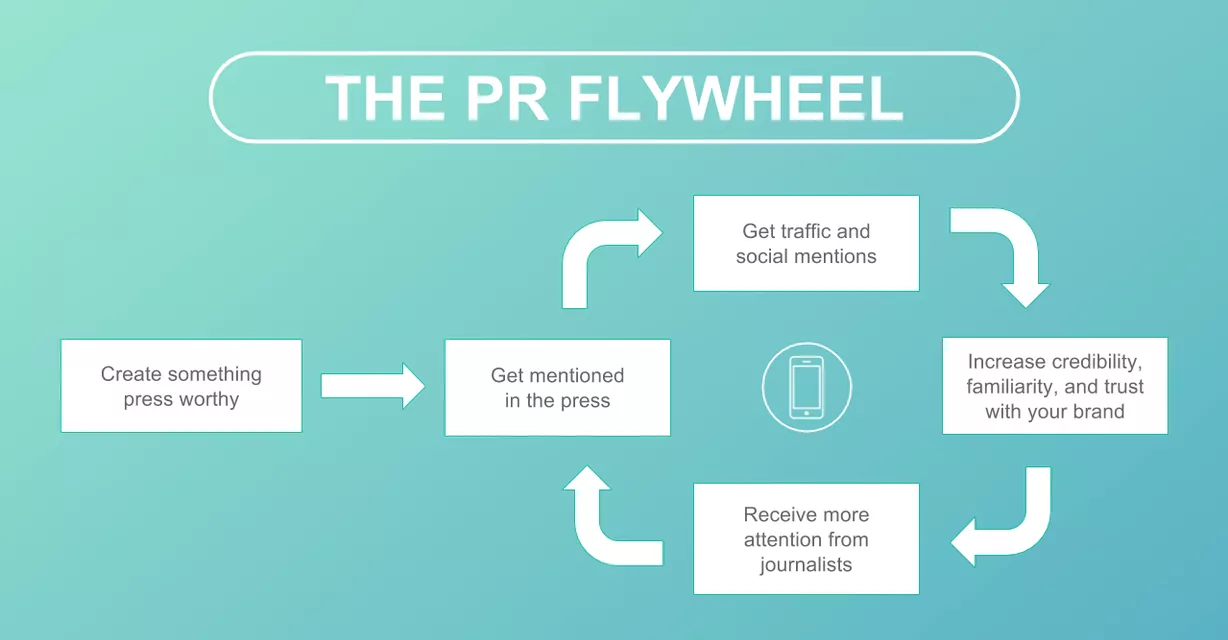
In the PR flywheel model marketing, creative ideas are the starting point. In this flywheel, you create relationships with the press and media, priming your pitches. The ideas you produce help you become viral and gain media attention. The buzz about your brand increases your visibility at a larger scale and attracts more fans and loyal customers, who will promote your business further.
Freemium Flywheel
In this flywheel, customers get free access to limited features of your services and products. If they find your service or product of use, they will promote it to others in exchange for unlocking more features for free or at a discounted price. As a result, this flywheel attracts a good amount of paid and free users, helping you increase your business growth.
Dropbox used the same flywheel to propel immense growth. Users could get only 2GB of free storage, increasing the limit by inviting their friends to the platform.
Referral Flywheel
You won’t believe it, but famous email newsletters like The Hustle have also used the referral flywheel to drive massive growth. First, to attract new subscribers, they use paid ads. Then, when subscribers invite their friends to join, they get rewards. The more referrals a user generates, the bigger rewards he receives.
You can use the same strategy for your firm. However, to receive maximum results, you can personalize this flywheel according to your needs.
But wait, do you know how to create a marketing flywheel? Probably not. Then let’s learn how to build it:
How To Create A Marketing FlyWheel – Read and Create
If you search on Google, you’ll find numerous bloggers suggesting so many ways to create a flywheel. And yes, there isn’t only one method to do so. Different businesses have different needs, and so their flywheel includes different steps.
To help you understand the basics of building a flywheel, we have put together the whole process into three simple steps:
Step One – Create Content For Your Buyer’s Journey
The first step in building your marketing flywheel is mapping out your buyer’s journey and creating content according to it. Then, follow the same steps that you did in the marketing funnel. Start by awarding people about your business, followed by other steps- interest, consideration, intent, evaluation, and purchase.
At different stages of the flywheel structure, use different types of content. Here’s the content strategy you should follow:
Awareness Stage
The content should include raising awareness about your expertise and how your brand can solve their problems. Remember- you don’t have to give the whole solution. But just an idea that you have their solution and to obtain that, they have to visit your website.
Consideration Stage
The visitor is convinced that you have a solution for their issues at this stage. You have to provide them with useful and valuable content that proves that your product or services can resolve all their problems.
Decision Stage
This stage is the game changer stage, and the content you provide here directly impacts your sales. Create content that helps your audience decide that your services or products are the best fit.
“Remember- Not Every Visitor Will Become Your Customer. So Do Not Try To Oversell Your Services Or Products.”
Help Tip: Apart from providing valuable content, give your customers something worth making their final decision in your favor. Free consultations, freemium tool offers, information regarding new webinars, etc.
Step Two: Use Topic Clusters
This step focuses on gaining organic traffic from search engines like Google through topic clusters. A topic cluster is a way to create and organize your content to establish your website’s authority on specific topics. Increasing the authority will attract more target organic traffic to your website.
Applying topic clusters on your blogs helps you rank high on Google, exposing you to a wider audience. Here’s how you can create your cluster:
- Start with identifying the key topic you would like to cover in your blogs.
- Once you know your topics, then comes the role of research. Research each topic in detail and identify subtopics for them.
- Then create content for each of these subheadings.
- Build a landing page to publish your content.
- Now place inbound links in your webpage with various topics.
That’s all! That’s how you can create clusters that help your website gain authority.
Now when you have created the right content for your website and know which content strategy to apply at which stage, it’s time to complete the wheel.
Step Three – Complete The Wheel
The last step in creating a marketing flywheel is providing your customers with a reason to promote you. Flywheel revolves when your existing customers promote your business and bring more clients to your website. Offering quality products or services isn’t enough to convince them that you are worth dealing with more than once. You have to create a positive and long relationship with your customers. And here are some ways to do that:
- By providing superior quality customer support during and after the buyer’s journey.
- Give them side benefits of promoting your business like- discounts or free coupons on a certain number of shares.
- Take surveys and ask their opinions about your services. Make them believe their opinions matter to you.
These are a few ways to complete your flywheel and successfully produce customers that will act as promoters for your brand.
Business Owners Views on Flywheel Approach
Let’s see what people who are using this approach in their business says about it:
Rex, CEO of Gadget Review:
“We use the marketing flywheel strategy as a comprehensive means of improving the customer experience and continuously building upon interconnected efforts to achieve the end goal. Marketing flywheel is a solid structure that helps us tie together all the elements of our business. Instead of just focusing on getting the sale, we have taken into account the gradual nature of the customer experience and everything that plays into that.”
Alina Clark, Growth Manager and Co-founder of CocoDoc:
“A flywheel is a system designed to store kinetic energy as efficiently as possible. At first, spinning a flywheel is difficult. However, once we create momentum, this form of gadget can spin and sustain its motion on its own. This concept is the foundation of the marketing wheel.
Companies can best serve their audience by combining marketing, distribution, and customer success departments, creating momentum and producing repeat sales and new consumers through word-of-mouth marketing.
You can use the flywheel to push referrals and repeat purchases by using the energy of your satisfied customers. In a nutshell, the company continues to run.”
Simon Elkjær, the Chief Marketing Officer of avXperten, home of Denmark’s most affordable electronics:
“Adopting the marketing flywheel model has opened our business to realizing our full potential and other multiple benefits. Besides making our customers feel more included in the entire process, it has also shifted our focus into further improving our products, service, and the overall experience we provide our customers with. In simpler terms, a marketing flywheel has made it easier for us to reach new customers while also making sure that we meet the demands of our industry.”
Daivat, Director of Operations at Force by Mojio:
“We use the marketing flywheel as an alternative to the more traditional marketing funnel model. The marketing flywheel guides our decisions on product design to customer success phone line messages. It gives all of our employees and managers an easy way to visualize customers’ important role in our company. We aren’t just laser-focused on creating new customers. We want to help, support, and nurture our customers’ experiences.
The flywheel has helped us set goals for our customer success team. For example, rather than think about customer retention and churn, we focus on how every aspect of the business can support customer experience before, during, and after they reach out with a concern or complaint.”
Ravi Parikh, CEO, RoverPass Campground Management Software:
“The marketing flywheel is an important part of how RoverPass brings teams together to set and reach common goals. Instead of viewing marketing, sales, and customer success as different stages of a process (like the funnel does), we look at all of these teams as critical for giving the best overall experience possible during the customer lifecycle.
We have found it easier to provide guidance and standards for employees in sales, marketing, and customer success when we take a customer-centered approach.”
After reading the above comments, a marketing flywheel is a must-try approach for businesses. It revolves around customer relationship management and is the future of marketing. But what is the core element that makes this strategy successful? The answer is:
Compound Effect Of Marketing Flywheels
When you include a marketing flywheel into your client’s buying process, you’ll discover how powerful it is. Furthermore, the flywheel shows a compounding effect in which you start receiving bigger results with the least effort. Let study this effect in detail:
Learn: How Flywheel Is Better Than Funnel Using Mathematics
** Tip: If you hate mathematics, just skip to the case study lines.**
The formula given below represents a business as a whole funnel. The formula determines the new customer growth, which helps to understand how efficiently you spend your sales and marketing budget to gain new customers.
The Funnel Equation For Customer Growth:
NCfunnel = ((TSE + TME) / CPL) x Conv
Where:
- NCfunnel= New Customers
- TSE= Total Sales Expenditures
- TME= Total Marketing Expenditures
- CPL= Cost Per Lead
- Conv= Conversion Rate(of leads to customer)
So, New Customers= ((Total Sales Expenditures + Total Marketing Expenditures) / Cost Per Lead) x Conversion Rate
K-factor in Flywheel:
The k-factor is a straightforward way to measure how your existing customers will help your company grow by measuring how willing and effective they are at promoting or referring your brand to more customers. It helps measure a client’s willingness and ability to attract other people to your business. You can also say that the K-factor measures organic growth or “an action-based measure of happiness.”
The formula for K-factor is as follows:
K= (i)(C)
Where:
- i= number of referrals per customer
- c= conversion rate of each referral
Suppose every customer tells 20 friends (i= 20) about your business, and each one of the referrals has a 35% chance of getting converted (c= 0.35). Therefore, K= 7.
The Impact Of K-factors On Your Customer Growth
Remember- Happy customers aren’t good to have. They are a must-have.
Let’s learn how K-factor impacts your customer growth:
So the first formula we learned was: NCfunnel = ((TSE + TME) / CPL) x Conv
Now, add the K-factor for flywheel in it, the formula becomes:
Note: Instead of knowing only the new customers, we use (1 + K) to represent the total number of new customers, including the existing customer base.
NCflywheel = [ ((TSE + TME) / CPL) x Conv ] x (1 + K)
OR
NC flywheel = NC funnel (1+K)
There the result comes out to be NC flywheel > NC funnel (1+K); as long as k > 0
So with a marketing flywheel, you can find ways to convert your customers into brand ambassadors who can refer you to new people. And these new people are undoubtedly your new leads. That’s how Flywheel marketing is better than Funnel marketing.
Let’s explain this with a case study: Your firm has a total marketing and sales budget of around $20,000, and you have 100 new customers. Let’s find out how many more customers these new ones will bring:
NCfunnel= 100
Suppose K factors is 1, then
k= 1; NCfunnel= 100 (1 + k) = 100 (1 + 1) = 100 (2) = 200
This result means that every 100 new customers brought you an extra 100 customers. This result further proves the benefit of the k-factor and thus marketing flywheel. A flywheel is the best way to increase the k-factor and thus new leads.
Know The Power Of Compounding From This REAL CASE STUDY of Hubspot
As said above, compounding is when you receive additional benefits or interest from your investment. Here is an example of the Hubspot flywheel that will show you the power of compounding. Look at this Hubspot’s organic traffic growth chart showing the results for compounding of marketing flywheel:
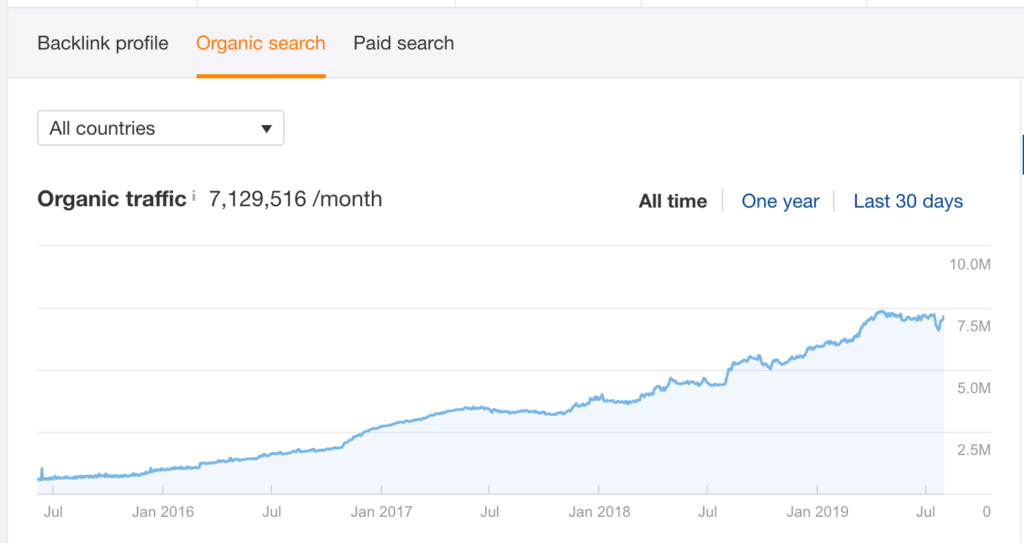
In July 2016, Hubspot was getting around 1M organic traffic every month. They used the compounding effect of a marketing flywheel to increase their traffic. What they did was- offer their customers interactive live sessions on social media, free eBooks, and other amazing features to make their visitor’s buyer journey more seamless.
And as you can see, From January 2017, their monthly traffic raised from 1M to 2.5M. And after July 2016, they have doubled their traffic. And today, Hubspot is getting four times more organic traffic than what they were getting in 2016. So they have been earning the investment’s interest that they have done in the earlier days in the form of increased traffic.
Momentum Is The Growth
The flywheel generates momentum as it spins. The faster the spinning, the more it builds momentum. And with each spin, your brand creates a large pool full of happy and satisfied customers.
Those clients are highly motivated to engage with your brand more- buy more of your services or products and promote your brand to others. This momentum results in more new leads, increasing the momentum of your marketing flywheel.
Just Imagine
Imagine a metal flywheel in a factory. It weighs quite high. You are trying to rotate it on the axle, putting in lots of effort. At first, it moved a little bit. Then finally, it completes a full round. The more you push, the faster it rotates.
Flywheel Multiplies The Marketing Efforts
Each round of the flywheel results from the efforts you placed earlier. It’s called compounding your investment of effort. First, one thousand times faster, then five thousand, and then ten hundred thousand faster. The huge and heavy wheel keeps on rotating with almost an unstoppable momentum. That’s what a marketing flywheel is known for.
It makes your marketing efforts many times more powerful, effective, and efficient. At the same time, with increasing momentum, it becomes easier to generate results. Hence, the faster a flywheel spins, the more momentum it builds and the greater your business grows.
Final Takeaways
Experts say that Marketing Flywheel is the key strategy behind the success of many popular brands. The most relevant example is Amazon. However, they had been practicing their version of this tactic long before it got into the spotlight.
Their wheel looked like this: in the early stages, Amazon lowered the price that increased its customers’ visits. Then, they focused on providing quality services at all the stages of their buyer’s journey.
As the number of customers increased, so did their sales volume, loyal customers, new leads, and commission from third-party vendors. That’s how their flywheel helped them grow back then and serve its purpose till today!
So, that’s all on market flywheels.
DO YOU WANT TO KNOW MORE WAYS TO GAIN IMMENSE TRAFFIC ON YOUR WEBSITE AND INCREASE YOUR NET SALES? LET US HELP YOU OUT!
